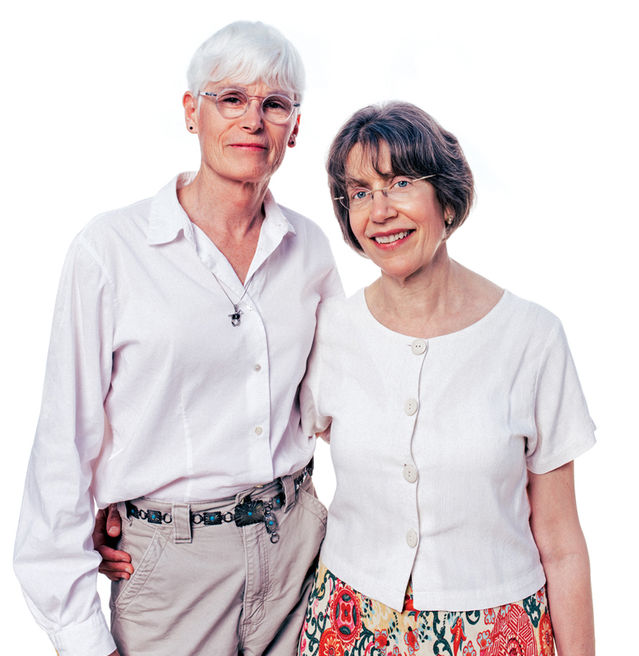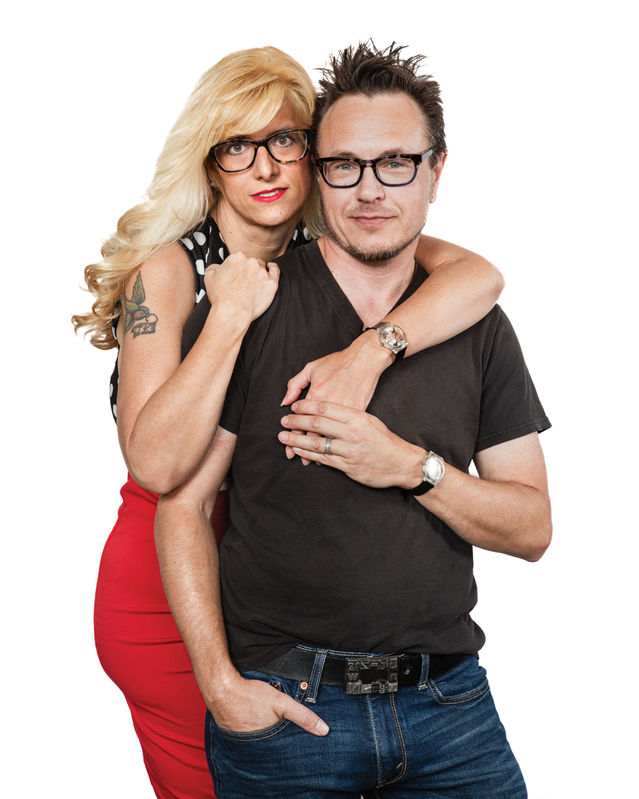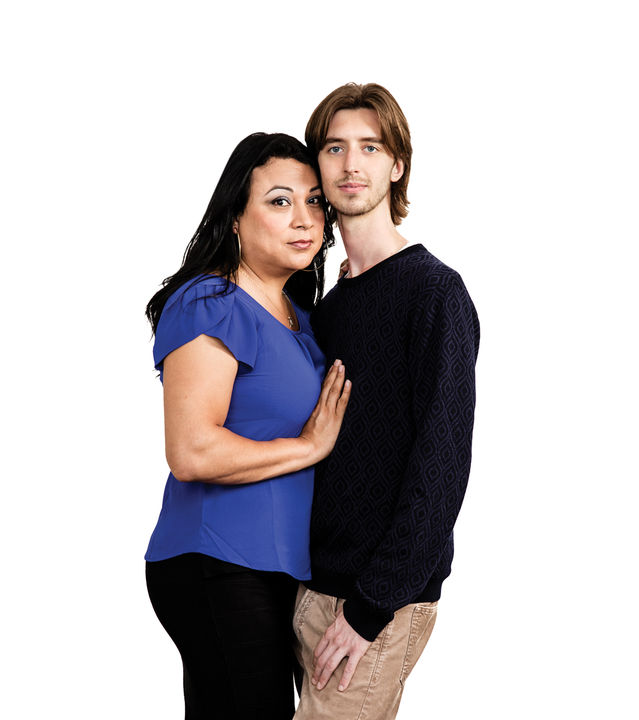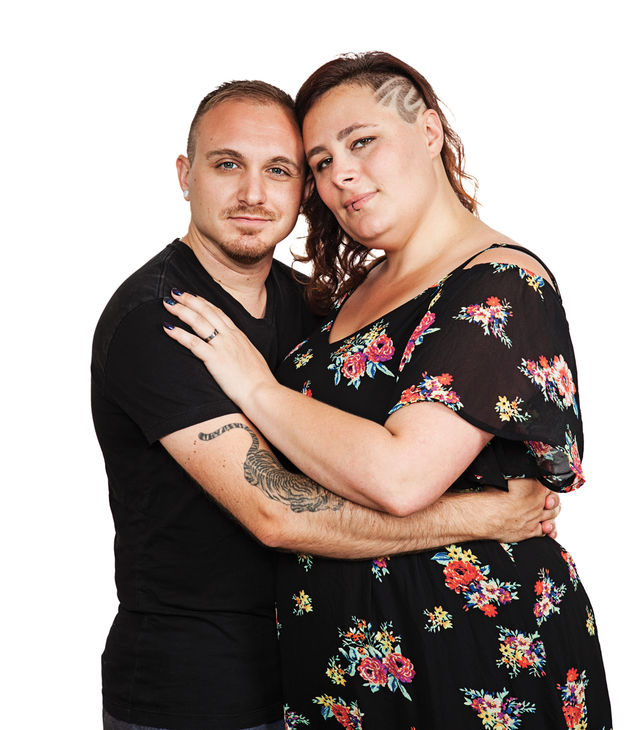Love Beyond Gender
It's a universal truth that relationships take work, but there's little precedent for what that work may involve when one's partner comes out as transgender. For couples who remain together through a gender transition, it can provoke a complicated reckoning with just how much—and who—has to change.
By Alysia Abbott published September 5, 2016 - last reviewed on September 5, 2016
On Marcia Livermore's second date with Michael Shattuck, in 1978, he told her that he occasionally liked to wear women's clothing. "I was a little taken aback," she says, recalling how he left the room after confessing the habit and returned in a dress. "I thought, This is kind of weird. I didn't know there were men who did that." Michael was a tall, thin landscape architecture student with a strong patrician nose, high forehead, and windswept hair. He was bright, sensitive, and compelling, and Marcia had felt almost instantly drawn to him. She guessed that his predilection for donning women's clothing was a sexual thing and accepted it as the sort of intimate secret that couples keep in the bedroom.
They got married and had two daughters whom they raised in the suburbs of Chicago. Michael assumed the bulk of the childrearing responsibilities while Marcia went to medical school. A decade into their marriage, Marcia was so consumed with the demands of her pathology residency that she didn't notice her husband's increasingly acute psychological distress. He was subsumed with pain about being a man—or rather, about impersonating a man, as it excruciatingly felt. There were moments when he contemplated climbing onto the roof of their house and diving head-first onto the patio. Then one day he called a suicide hotline and was told about discreet meeting groups for people who sense that their true gender is at odds with their bodies, a psychological condition known as gender dysphoria.
Reaching out to these support groups was a revelation for Michael. For the first time, there was a language, a framework, to acknowledge what he felt—that he was, in fact, a transgender woman. Michael became Trisha and proceeded in tiny baby steps to alter her appearance. "It was sort of like, 'This is who I am—I have to do this,'" Marcia recalls. Trisha grew her hair long, dyed it blonde, and donned earrings. She had a "tracheal shave" to reduce her Adam's apple, underwent rhinoplasty and electrolysis, and started a regimen of hormone therapy. She went through a kind of belated adolescent girlhood, strutting around in short skirts and high heels before settling into a more mature woman's wardrobe, with a style she refers to as "school marm librarian."
Trisha's contentment and happiness grew in concert with her newfound freedom to publicly be a woman. But for Marcia, the experience unleashed an avalanche of anguish. She still loved her spouse, but the change rocked her own life and identity. "Part of me felt betrayed," she says. "I was hurt and angry. We had arguments and a lot of tears. I would look at her and think, 'You look really, really feminine—and I'm not attracted to women. This is who Trisha is, but this isn't who I am.'"
Marcia missed the man she had married and the life they had had together. "It was a real loss," she says. They tried seeing therapists, though few in the late '80s and early '90s had any acquaintance with, let alone expertise in, transgender issues. Their daughters, on the cusp of adolescence and navigating their own tumultuous response to their father's transformation, asked their parents point-blank to split up. The couple came close to getting divorced several times. "There were just two choices," Marcia says. "I could learn to adapt and figure out how to compromise, or we could separate."

Choosing to stay married, they moved to a town in Michigan where there were fewer raised eyebrows and nosy inquiries, and went on with their lives. "I came to understand that our relationship was really unchanged," says Marcia, whose family's story is told in a documentary, From This Day Forward, directed by their now-grown daughter Sharon, which will be broadcast as part of the PBS series POV in October 2016. "We still felt the same way about each other. I had a sense of mourning for the public perception of us as a couple, but I realized that public perception doesn't matter—what matters is how we relate to one another. We love each other on a plane that's hard to describe. Trisha is my soul mate. It was hard to stay together, but it would have been harder to be apart."
RIPPLES OF CHANGE
We're living in a time of unprecedented visibility for transgender people. Transgender characters populate award-winning television shows like Transparent and Orange Is the New Black, transgender celebrities like Caitlyn Jenner, Janet Mock, and the Wachowski siblings garner significant coverage, and controversies over subjects like the bathroom rights of transgender individuals have helped spread awareness of a long-marginalized community and the discrimination and danger it regularly faces.
While the public has become increasingly aware of the presence and struggles of transgender people, however, one of the most significant facts of their lives has remained largely hidden from view—the experience of their romantic partners. Transgender people are estimated to comprise 0.6 percent of the population, or about 1.4 million adults in the United States. Many of them have partners at the time of their gender transition. It might be expected that a shift so fundamental to the fabric of a romantic relationship would invariably drive couples apart, but that is not necessarily what is happening. There are couples who are choosing to stay together—through unprecedented challenges to their sense of self, their sexuality, and the nature of love. Their experiences defy any kind of categorization. But all of them are testaments to the extraordinary intricacy of human nature.
To the degree that anything about gender transition can be said to be traditional, the traditional scenario involves a married man who "comes out" at 50 when his wife discovers a wardrobe of women's clothes hidden in his closet, says Syracuse University marriage and family expert Deborah Anne Coolhart. The wife then takes the kids and leaves him. But that is no longer the dominant pattern. "More and more couples are staying together," says Coolhart, who works with families of transgender people. "A key is when and how the disclosure happens." If at the beginning of a relationship one person confides that he or she isn't typically gendered, the other may be able to handle a transition better than someone whose partner harbored a secret for 20 years. And as society gains more awareness of gender variation, trans people are coming out younger.
But even for couples who do stay together through a gender transition, there's often a sense of betrayal, loss, and abandonment, says Maureen Osborne, a clinical psychologist who has specialized in gender identity issues for more than two decades. Partners face feelings of damage to their trust and a sense of loss of their shared history. In addition to anxiety about disclosure, couples often endure rejection by family and community, financial hardship related to medical procedures, and fear for the trans person's safety.
In the midst of gender transition, a trans person can be very self-preoccupied, Osborne says, and a partner may feel minimized by the significant other's attitude that 'It's all about me.' "Transitioning is like going through another puberty," Osborne says. "When there's a part of yourself that you've suppressed your whole life that suddenly you've given yourself permission to express, it's exciting and freeing. But the partner can feel as if he or she is suddenly married to a teenager. 'Selfish' and 'narcissistic' are two words I hear all the time from spouses."
Physical intimacy is the huge question mark at the center of couple life. "If you're attracted only to men, and you have a partner who's now female, that's an obstacle that can't be changed," Coolhart says. Nevertheless, couples live out a vast range of scenarios, as some people undergo surgery to alter their bodies while others don't, and some couples remain sexually active while others suspend intimacy. Couples have to decide how else they're going to get their needs met if their mutual desire is gone, or if they will be sexual with each other despite changes in gender and sometimes physiology. "Sometimes, people have such a strong connection that it transcends body parts," Coolhart observes.
For Diane Anderson-Minshall, the dilemma was less about anatomy than it was about sexual orientation. Having grown up in a cloistered community in rural Idaho, she cherished the proud, vibrant lesbian community she became a part of in her early adulthood. In 1990, when she met her girlfriend, Suzanne, known as Suzy, they were "two little baby dykes, one butch, one femme," she says. They were together for 16 years when Suzy started reading about transgender identity and gender fluidity. "I could see the wheels turning," Anderson-Minshall recalls.
Suzy became Jacob, and Anderson-Minshall didn't hesitate to support him and honor their commitment to each other. The real struggle, she discovered, was with her own sense of self. How could she still be a lesbian, she wondered, if she was now in a male-female relationship? Anderson-Minshall had identified as a femme lesbian for most of her grown life. With a butch woman at her side, this status was never in doubt. "It was clear to the world that we were queer," she says. "But as soon as that was stripped away, suddenly my queerness became precarious. I was a woman walking with a man."
Anderson-Minshall remembers the first six months of Jacob's gender transition as a period of "backlash and overcompensation. I went to a grocery store and someone said, 'I like your blouse,' and I said, 'It was a gift from my husband who used to be my wife...I was a lesbian...I'm still a lesbian!' I was constantly needing to reassert my lesbian identity." After much internal wrestling, she came to feel that she didn't have to give up her own sexual identity to continue loving Jacob. "Being a lesbian doesn't have to do with my partner's genitals or gender identity," she said. "I'm a part of this community. The sisterhood doesn't go away."

In some ways, reconsideration of sexual identity can be easier for couples who initially identified as gay—in many cases, those who identified as lesbian before one partner transitioned to being male—because they've already experienced life as a sexual minority. "When a couple has had to deal with the challenges of being outside the societal norm, they can be better equipped to handle the pressures of a partner's transition," says Coolhart. "It's different for heteronormative couples. A woman whose partner is transitioning may say, 'Okay, I married a man as a heterosexual woman, and now my husband is going to be a woman. What does that mean about me? I'm definitely not a lesbian, but I love this person.' It's really hard to figure out how to navigate these new dynamics."
CONSTRAINTS OF MASCULINITY
Clinicians who work with the transgender community frequently say that it's not just individuals who transition but their loved ones as well. Likewise, the stigma transgender people face can extend to their partners and families. Of all the permutations of intimate relationships, the one most societally disparaged is that of the straight-identified man who dates a transgender woman. "Men who are attracted to and date transgender women are probably stigmatized more than transwomen are," transgender actress Laverne Cox said in an interview last year on Sirius XM. "As I date a lot of straight-identified men, I've seen them so deeply internalize these very rigid ideas about what it means to be a man—a straight man."
Thomas Matt, a 23-year-old from upstate New York, had never met a transgender woman before he went to Thailand on a high school exchange program. "In America, trans people are visible only in cities," he says. "But in Thailand, no matter where you are, even in the smallest towns, you meet trans people." There, Matt, who identifies as heterosexual, first recognized his attraction to transgender women. When he returned to Thailand to study during his sophomore year of college, he dated a transgender woman. But after returning home, he was reluctant to tell people about his relationship.
Secrecy is common among straight men who date transwomen, according to Walter Bockting, the codirector of the Program for the Study of LGBT Health at Columbia University, who surveyed such men in a 2011 study. "It isn't hard for them to develop sexual relationships," Bockting says. "They may fall in love, and it doesn't threaten their identity. But it is very difficult for them to bring that relationship out in the open. To present as a couple to the world and to their family is a really big hurdle. Fearing rejection, they can't integrate these relationships into their lives, so they end up feeling very isolated."
Kristi Gamarel, a research fellow in psychiatry at Brown University, has found similar effects. "Stigma and discrimination trickle down into how couples feel about their relationship, and that affects the cisgender partner's mental health," she says, using a term that means nontransgender. "The strongest mental health effects were seen among men who identified as heterosexual."
The extreme shaming of men who date transwomen is an outcome of the pressure to "stay within the lines" of masculinity and heterosexuality, says Coolhart. Many people refuse to acknowledge transwomen as anything but men in disguise, which makes straight men who date them at risk of being perceived as gay, potentially inciting their own homophobia, humiliation, and, frequently, aggression. Some men accused of abusing or murdering transwomen have even tried to mount a legal argument dubbed "trans panic," which proposes that they became temporarily insane when their heterosexuality was impugned. "Men are constrained by gender policing," Coolhart says. "They have to be macho."
After returning from Thailand the second time, Matt started researching issues the transgender community faces. After learning about the violence and abuse often directed at transwomen by their secretive boyfriends, he decided to publicly come out about his taboo attraction in an essay that was published on Salon. "The article was personal," he says. "It helped liberate me after years of being confused and ashamed about being trans-attracted. And part of it was to deal with my own community of trans-attracted men, some of whom abuse transwomen."

Matt is now dating Jennicet Gutiérrez, a transwoman and activist who friended him on Facebook after reading his essay. Her previous relationship had been with a man who would see her only at night and who eventually became emotionally and verbally abusive. "He was basically saying, 'This is what you can get. No one else is going to want to be seen with you. They'll be embarrassed,'" Gutiérrez says. In comparison, she was taken aback when Matt, on one of their early dates, suggested they go meet his sister for lunch near her office. "Just going to meet her was something I couldn't get around," Gutiérrez says. "It made me feel valued. My previous boyfriend never introduced me to his family or friends."
Some men may be public about their relationship from the start but conceal that their partner is transgender, a possibility if she completely "passes" as female. Andrew and Anna met on OKCupid a few years ago when both were in their early 20s and living about an hour away from each other in Michigan. (They asked to be referred to by pseudonyms to protect their privacy.) Anna looked pretty in her picture, but what really grabbed Andrew was the offbeat movies, like Monty Python and the Holy Grail, that she listed as favorites in her profile. They struck up a flirty rapport online and soon decided to meet in person. Anna said she needed to tell him something first, and over the phone she revealed that she was transgender.
Andrew had never considered being with a transgender woman, but he really liked Anna, so he was undeterred. They met, felt a spark, and proceeded as most young couples do: dating, growing closer, meeting each other's families, and talking about a future together. After a few months, he felt compelled to tell his mother about her gender identity. "I was nervous as hell," he says. "There's no cultural narrative about how to tell your family you're dating someone who's trans. I knew I'd get support from my mom no matter what—she's a pretty liberal person. But I wasn't sure she'd necessarily understand." Andrew's mom was accepting, although he hasn't told anyone else since then, including his two brothers. "I've never seen it as my place to disclose Anna's identity," he says. "I don't want to change people's opinion of her."
Last spring, they married. "To be completely honest, half the time I forget about it," Andrew says about Anna's transgender status. Still, he's aware of the negative perception that could color both of them were the truth widely known. "I think there's a pernicious attitude that people who date transwomen are somehow less manly, or are screwed up, or can't get a 'real woman,'" he says. "That's all wrong, although those of us in my position can't really come out and say, 'I'm dating a transwoman.' There's a barrier to making our presence and personal story known."
YOUTH BRIGADE
Like many people who came of age after the airing of Ellen and Will and Grace, Sunni Brydum never thought of being gay as anything but normal. She had a lesbian teacher in first grade, and by the time she reached high school, she felt free to identify openly as bisexual. In college, with a minor in LGBT studies, her mind was opened to the idea that gender identity and sexual orientation aren't necessarily linked, and that both exist on a continuum. "It really gave me a more nuanced understanding," she says, "I took a step away from the gender binary myself and came to embrace the label 'queer.' I was attracted to all genders and liked how that label says, 'There's space for you under our big rainbow-umbrella tent.'"
She was 23 when she met Mac, a transgender man a year younger than she who had already transitioned. He had facial hair and a voice lowered after being on testosterone, and he'd had top surgery, a term for breast removal and chest reconstruction. Although Sunni knew trans people, she had never dated one, so she was a little nervous about betraying a lack of knowledge when they started becoming intimate. "I like to think he didn't have to give me too much Trans 101," she jokes.
Neither was looking for a relationship at the time, yet they fell in love quickly. "We had great conversations more than anything," Mac says. "I trusted her instantly." And the timing of their meeting didn't require either to adjust their identities. "We had the ideal situation because we were both already identifying as queer," Sunni says. "I'd be queer whether or not I was with a trans person—that's part of who I am. And he was already presenting as the man that he is before I met him, so that was never really a big deal for us. We didn't have a lot of hurdles."
There's a striking generational divide when it comes to how gender is understood, and it's carrying over into intimate relationships. "Young people are really leading the way toward a much less binary-identified culture in this country," Osborne says. "As we started to become more accepting of transgender people, that was a breakthrough that gave people blanket permission to look at their gender and sexual identities." The result, she says, is that more and more young trans people are connecting with labels outside the narrowly defined constraints of man and woman: Among the 51 new gender options that Facebook made available to users in 2014 are bigender, gender variant, gender nonconforming, genderqueer, genderfluid, and nonbinary.
Even though young people are more fluent in the nuances of gender and may have an easier time embracing their own or their partner's trans status, it doesn't necessarily mean that their relationships are free of gender-related stressors. Sarah Eley, a behavioral health therapist who facilitates a monthly support group for partners of trans people in Boston, sees many in their mid 20s and below who are comfortable with the concept of gender fluidity, but "have a lot of the same issues around isolation, disclosure, or how they present." And if the transition begins while they're already in the relationship, they face issues related to the change—changes in attraction, in sexual intimacy, in public perception. "Identity and attraction change a lot when someone is shifting his or her gender," Eley says. "There are just as many relationships that break up when a transition happens as there are that stay together."
Sunni and Mac had advantages besides having met after his transition. Sunni's parents accepted Mac's trans identity and gave the relationship their blessing. Mac, after some rocky years with members of his family, reconnected with them and gained their love and support. Having both worked for LGBT organizations and been active in LGBT social causes, they were embedded within a strong, trans-friendly social network and felt safe and secure being out about Mac's gender identity.

Last August in the Colorado mountains, they had what Sunni calls "our pretty, queer wedding." It was drizzling that day, but the sky cleared just as the ceremony began in the middle of a meadow. Having "bridesmaids" and "groomsmen" had felt too gendered, so they instead each had three designated "party people" as honored attendants—two of Mac's were gender-nonconforming friends from college. Sunni and Mac walked down the aisle together holding hands and stood between two maypoles hung with rainbow ribbons made by Sunni's mother. The pastor who married them had been Mac's mentor in college and a strong source of support during his transition. Dozens of friends and family members beamed at what they witnessed: two humans, standing in the summer sun, vowing to love and honor each other forever.
Submit your response to this story to letters@psychologytoday.com. If you would like us to consider your letter for publication, please include your name, city, and state. Letters may be edited for length and clarity.
For more stories like this one, subscribe to Psychology Today, where this piece originally appeared.
